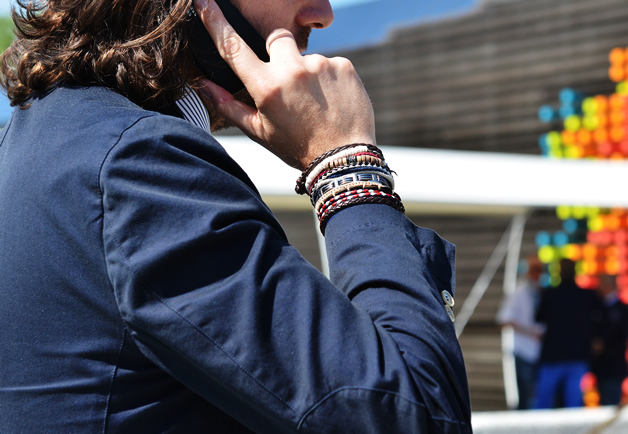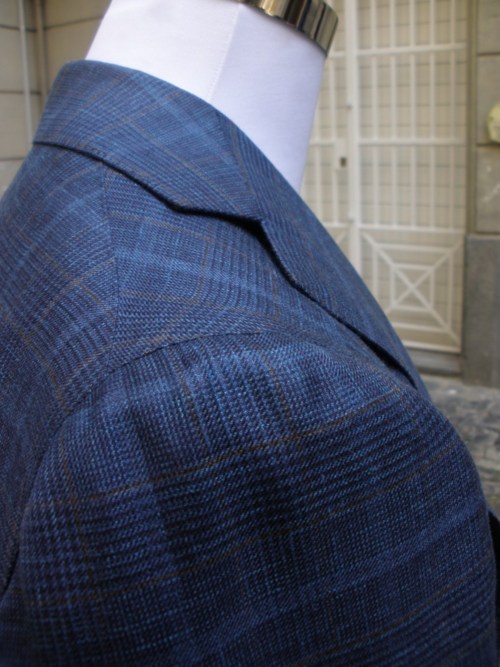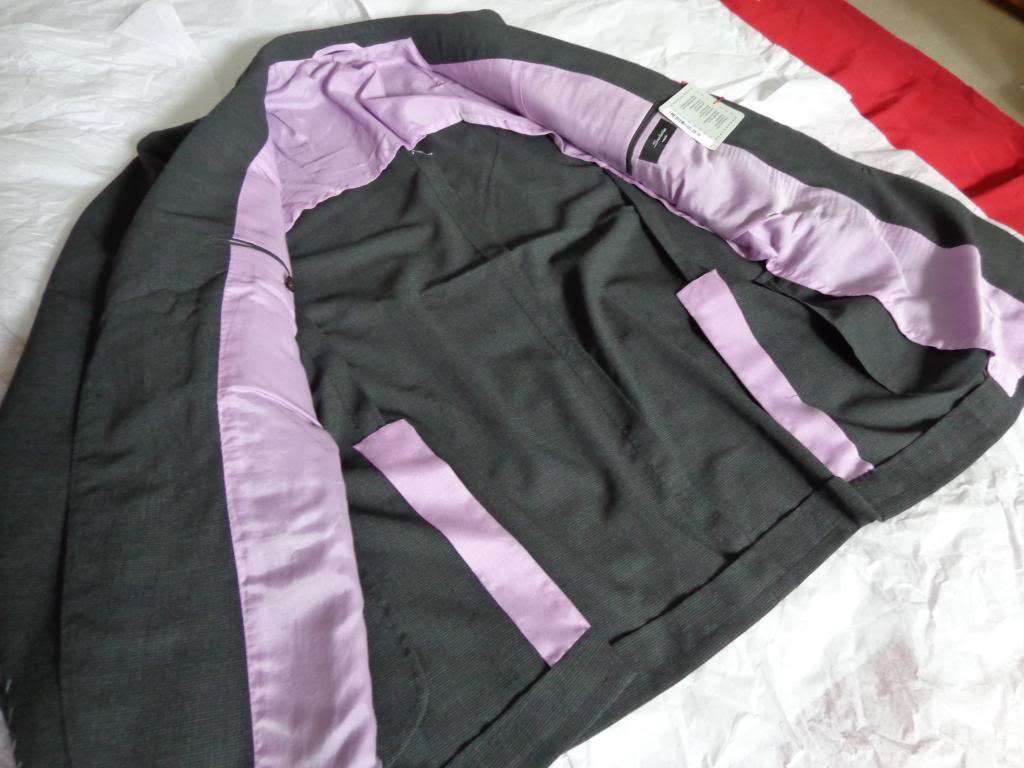Parisian Gentleman - © 2009-2020 - Mentions légales - Réalisé par HVLD digital

Peering out past the sweep of the great bay of Naples, there is a sense of ancient history steeped in sedimentary stone, as well as rich stories of the past echoing in the eyes of the people. When we think of historical cities, often our minds turn towards the art that represents the region.
Yet remarkably, the main art associated with Naples today is not music, theatre, painting or dancing...rather, it is the art of tailoring. The historical and present-day tailoring talent in the city of Naples has found such success that it has earned it own classification: Neapolitan tailoring.
Some say that that Italian tailors are so perceptive of the body morphology of a client, that curiously, fewer fittings than usual are necessary to get an exceptional fit. Perhaps Italian tailors have developed a 'sixth-sense' for their craft, since elements of the trade permeate their pores, beginning as early as the age of eight or nine, when these tailors first put a needle to the cloth...or maybe the very essence of being Italian naturally interjects emotion into the cloth that they craft.
But in Italy, there is no question that this specific type of tailoring that is unique to the world, called 'Neapolitan tailoring', has made a name for itself in this culturally rich and impossibly colloquial city of Naples, Italy.

The modern day workshop of Rubinacci. (Exclusive photo, Parisian Gentleman)
Sandwiched between a sleeping volcano and the steaming Campi Flegrei, Naples is a rumbling mass of grit and glory, and has long been a centre of art and architecture, spattered with Medieval, Baroque and Renaissance-era castles, palaces, and churches.
The lure of history runs deep in the blood of the Neapolitan, and the city is situated in a way that before the days of mass transportation, left it somewhat isolated from other influences. This sequestering of Naples from outside influences may have contributed to the success of creating the Neapolitan Jacket, designed and refined to cater to the climate and style preferences specific to the area.

Procida, Naples, Italy (iStockphoto/Thinkstock)
These days, the charmingly chaotic Naples is struggling with trash management issues and like many major cities is riddled with vandalism and pick-pockets. But even with all of its issues, The UNESCO evaluation committee describes Naples' centre as being "of exceptional value", and goes on to say that Naples' setting on the Bay of Naples "gives it an outstanding universal value which has had a profound influence".
What is it about the Neapolitan jacket that draws the eye of so many men? A Neapolitan jacket oozes coolness and Italian nonchalance, or sprezzatura, and feels a little edgier than the classics with young men in particularly recognizing the versatility of this soft-tailored jacket.

Even as made-to-measure and ready-to-wear suit-makers across the globe blaze a trail of their own by offering Neapolitan crafted suits, it has become obvious that those predictions from the past that told us that Neapolitan suits are likely a fad, have proved the contrary, and Neapolitan tailoring has shown its viability and entrenched itself firmly into the league of becoming a classic in its own right
Although it is sometimes perceived otherwise, the history of tailoring in Italy that lead to the Neapolitan jacket design that we know today, isn't that old (although tailoring for aristocrats and dandies dates back several centuries). The rise of Neapolitan tailoring began to take root in the early 1900s, where we find on the scene, Angelo Blasi , who has become one of the most famous tailors in Italy. At the time, Mr. Blasi finds his inspiration in English tailoring (a structured coat with padded and narrowed shoulders), and crafts his work to emulate many of the characteristics that he sees in the suits coming out of London.
Yet, as a contemporary of Blasi, it is Vincenzo Attolini - head cutter at Rubinacci's tailoring shop called the London house (in Napoli) - that ushers into the city of Naples, the distinct look of Neapolitan tailoring, as we know it today.

Tailor Domenico Caraceni of Rome, whose work possibly inspired Neapolitan tailoring, in the 1930s --far right (source: IPS Community: A Golden Age of Italian Tailoring )
Has Attolini been inspired by the work of Rome's Domenico Caraceni, another master tailor known for making suits with soft lines? We'll never know for sure, but it is at this point, that Attolini abandons the more structured methods of British suit-making even veering away from elements of British tailoring that Blassi favored, and creates a distinct jacket that can be recognized by the trained eye, as being "Neapolitan".
Vincenzo removes the coat pads and inner linings, adds his own fine details, and makes a jacket so light that it can be folded up to eight times...a revolution in tailoring that will lead to the invention of the modern jacket.
In knowing part of the story of Italian tailoring, it becomes easier to understand that just because a suit hails from Naples, it does not mean that the suit is a classic Neapolitan suit, as the roots of tailoring in Naples also include a very present early English influence, which is why Naples also crafts a substantial number of Roman style structured suits.
In order to identify a classic Neapolitan Suit, pay attention to:
1. SOFT SHOULDERS (no padding, pleated sleeve head -- spalla camicia or con rollino).
As the Neapolitan shoulder can be quite confusing to many, BespoKenN does an exceptional job illustrating the differences between two frequent Neapolitan shoulder constructions: the spalla camicia and the con rollino):

Spalla camicia adopts a similar technique that is used in shirt-making . By tucking the seam allowance against the shoulder (not against the sleeve), the jacket follows the shape of the body causing the fabric to fall naturally from the shoulder-down. There is an absence of padding in the shoulder and a natural puckering that is formed flowing down from the sleeve head, since sleeves are cut wider at the top with excess cloth eased into the shoulder and armhole--a look thought of as a fault to some, and pure poetry in motion to others. Notice how the shoulder is knocked down, with no appearance of padding.
Con rollino (or "with roll") jackets are made by taking excess fabric from around the sleeve head, and forming a roll that bulks up the area and pushes the sleeve head upwards, creating a bump that gives the same appearance as roping. Sometimes this bump or roll can be quite pronounced, and other times, not as obvious.

© Ezra Paul (ezrapaul.com)

A spalla camicia shoulder, also called a "shirt-shoulder" by Napoli Su Misura.
2. MINIMAL (SILK) LINING INSIDE THE JACKET
As the climate in Naples can be sultry, if not at times stifling, a lot of attention is focused on making the lightest and coolest ensemble possible, while still upholding a good suit structure. Because of this, a Neapolitan suit coat will be of a light structure and will typically have a very small amount of lining inside, with the goal being that the coat should fit like a second skin.

Vintage Sartorio Napoli by Kiton (source: styleforum)
3. PATCH POCKETS ( tasca a pignata)
The lower patch pockets on a Neapolitan jacket are modeled after the tasca a pignata style, and when done in its purest form, are easily recognizable with a rounded-bottom and a unique shape.

The shape of a true Tasca a Pignata patch pocket is likened to the shape of a brandy snifter.

A Tasca a Pignata Neapolitan patch pocket
4. THE CHEST POCKET IS CUT A BARCHETTA (in a boat shape)

The barchetta curved welt breast pocket on a new bespoke Napolisumisura (Mina Adamo) odd jacket.
5. BUTTONS : 3 on 2 roll

On this 3-button (with two buttons working) single-breasted coat, the third nonworking button/button hole is inserted into the lapel to give more structure and create a larger belly inside the lapel roll. This is referred to as the "tre buttoni su due" and is a detail you can only have in a handmade jacket, as the buttonhole worked into the lapel is made upside-down.
Of course, the 3 on 2 is not exclusive to Neapolitan tailoring, and can be witnessed in Paris or London.
6. A HIGHER NOTCH AND GORGE SETTING

A higher gorge and notch is likely to be seen in a Neapolitan Jacket, but once again, it is not exclusive to the tailoring style, as houses such as Cifonelli in Paris are also known for raising the gorge and notch.
7. DOUBLE HANDMADE BACKSTITCH ON LAPEL AND POCKETS

The typical double backstitch on the Neapolitan lapel is called Doppia Impuntura (Sartoria Caliendo, Naples, credit:The Rake Online)
8. THE FINAL CUT

As demonstrated by Luca Rubinacci, the front dart on the coat extends all the way to the bottom hem to create a more streamlined look, the back is cut with a reasonable amount of waist suppression, sleeves are tapered with overlapping, or "kissing" buttons, and the overall jacket is slightly shorter than a classic English jacket.

Sprezzatura, an Italian word originating from Baldassare Castoiglione’s book, The Book of Courtier, states that sprezzatura alludes to a certain nonchalance, so as to conceal all art and make whatever one does or says appear to be without effort and almost without any thought about it.
It seems that with each hour the Englishman spends attending to the fine details of dressing, the Italian gentleman will spend an equal amount of time making it look as if he has not attended to the fine details of dressing. And, perhaps this is part of the reason that Neapolitan tailoring continues to endure, since it not only describes a specific style, but also an attitude towards putting others at ease, being naturally elegant, and a spirit of not-so-accidental nonchalance.
further reading/sources:
Opening and final photo: Cesare Attolini
Irenebrination Tailoring, Neapolitan School
The Telegraph Luxury: Roadmap to Success, Italian Style
Italian Fashion - Neapolitan Tailored Jacket - La Giacca Napoleta